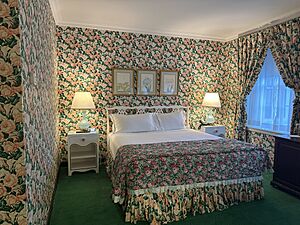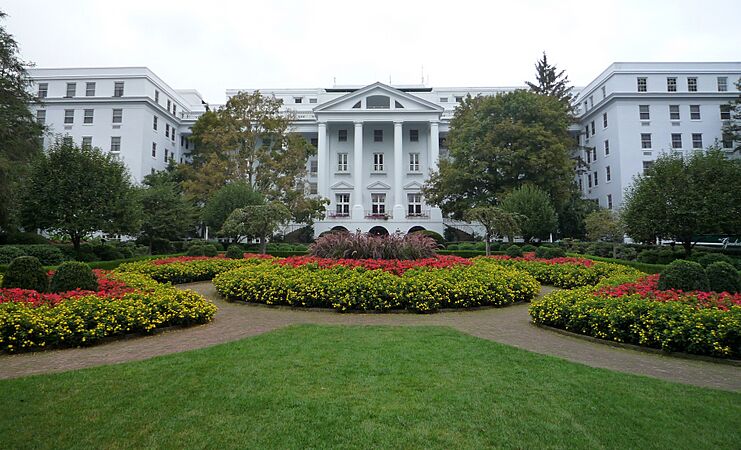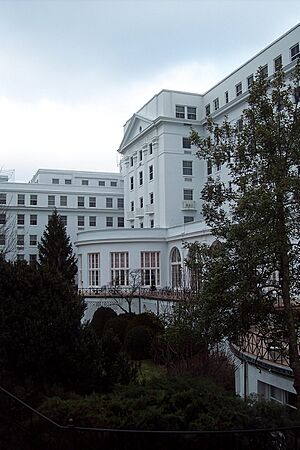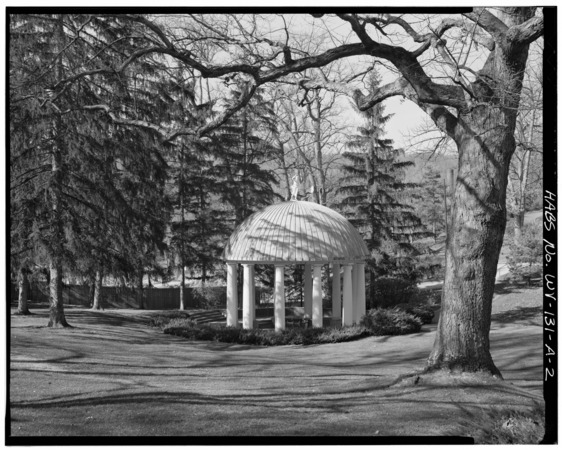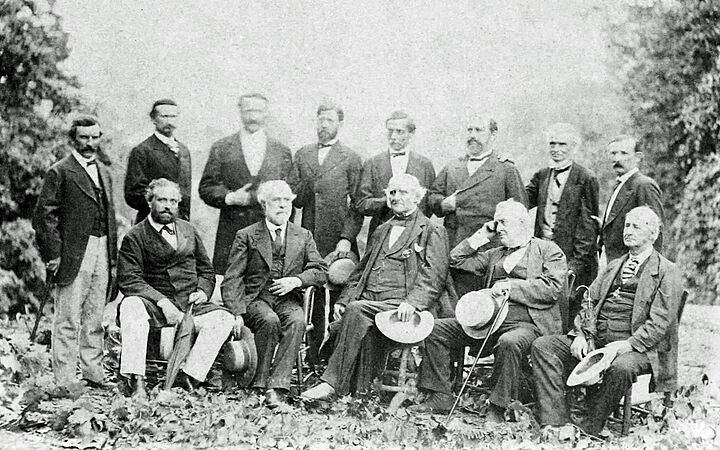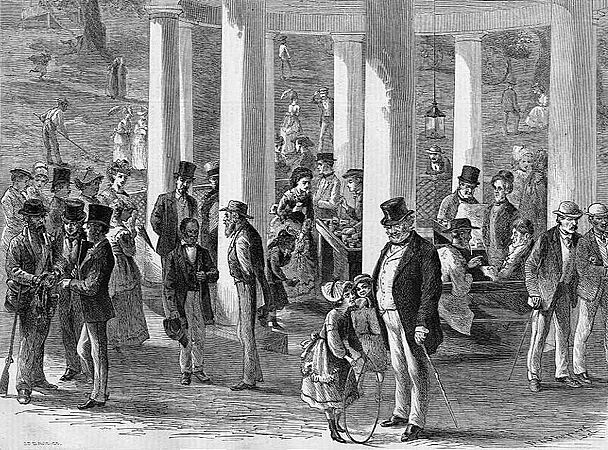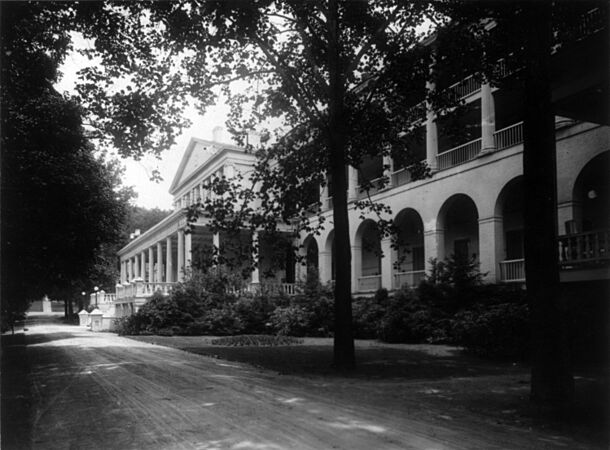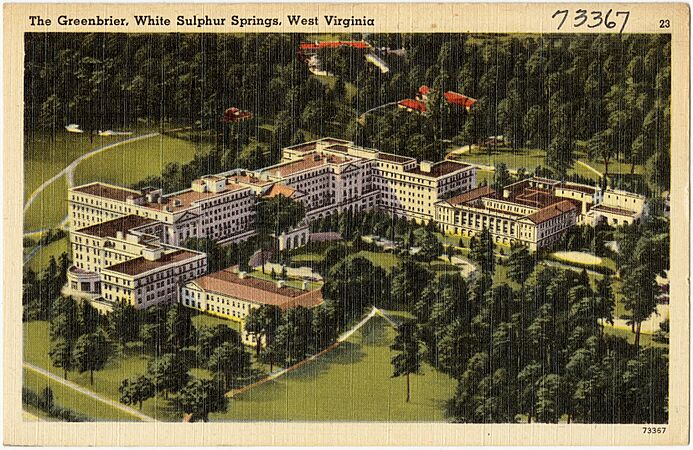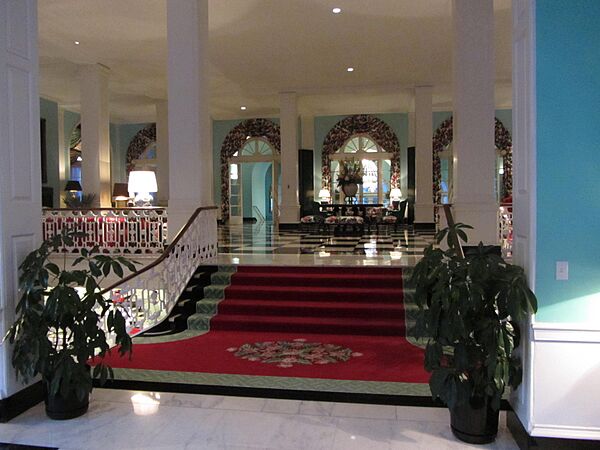The Greenbrier facts for kids
Quick facts for kids The Greenbrier |
|
|---|---|
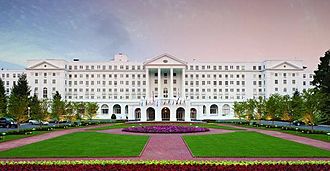
Main entrance in 2011
|
|
| General information | |
| Address | 101 Main Street West |
| Town or city | White Sulphur Springs, West Virginia |
| Country | United States |
| Opened | September 25, 1913 |
| Owner | Justice Family Group |
| Grounds | 11,000 acres (4,500 ha) |
| Other information | |
| Number of rooms | 710 |
| Number of suites | 33 |
| Number of restaurants | 9 |
| Number of bars | 11 |
|
The Greenbrier
|
|
| Architect | John H.B. Latrobe et al. |
| Architectural style | Classical revival, Federal |
| NRHP reference No. | 74002000 |
| Significant dates | |
| Added to NRHP | October 9, 1974 |
| Designated NHLD | June 21, 1990 |
The Greenbrier is a famous luxury resort. It is located in the Allegheny Mountains near White Sulphur Springs, West Virginia in the United States.
People have visited this area since 1778. They came to "take the waters" from the local springs. Today, The Greenbrier sits on 11,000 acres of land. It has 710 guest rooms and many places to eat. There are also over 55 fun activities and more than 35 shops.
The main Greenbrier building was built in 1913. The Chesapeake and Ohio Railway owned it for a long time. In 2009, a company owned by Jim Justice bought the resort. He promised to make it a top-rated, five-star resort again. He also added "tasteful" gambling for guests.
Many important people have stayed at The Greenbrier. A total of 28 U.S. presidents have visited the hotel. The last president to stay there while in office was Dwight D. Eisenhower.
The Greenbrier also hides a huge secret. It has an underground bunker built during the Cold War. This bunker was a secret shelter for the United States Congress. It was code-named "Project Greek Island".
The Greenbrier's Long History
Early Days and the Sulphur Spring
At the heart of the resort is a special sulphur water spring. A white-columned building with a green dome covers it. This dome has been The Greenbrier's symbol for many years.
In 1778, a local woman named Mrs. Anderson used the spring water. She learned from Native American traditions. The water helped her feel better from her rheumatism. For 125 years, the resort was known as White Sulphur Springs. People came in the summers to escape the heat and sickness from the coast.
A family from Baltimore, the Calwells, bought the land. They built it into a resort. They sold small cottages to important people from the South. Famous guests included Martin Van Buren and Henry Clay.
In 1858, a huge hotel called the Grand Central Hotel was built. People called it "The White" or "The Old White." During the American Civil War, the resort was used by both sides. Soldiers almost burned it down.
After the war, the resort reopened. It became a place where people from the North and South could relax. It even hosted important meetings to help bring the country back together. General Robert E. Lee wrote a famous paper there. The railroad arrived in 1869, making it easier for guests to visit.
Building The Greenbrier Resort
In 1910, the Chesapeake & Ohio Railway bought the resort. They added new buildings, including a bath wing in 1911. The biggest change was a huge six-story hotel. It had 250 rooms and opened on September 25, 1913. This building is the center of today's hotel.
The resort became a year-round destination. Its name officially changed to The Greenbrier. This name came from the nearby county. The railroad also brought the game of golf to the resort. The first 18-hole course opened in 1913. It is now called "The Old White TPC." The old "Old White" hotel was torn down in 1922. A new north wing was added in 1931, making the hotel much bigger.
World War II and a New Look
When the United States entered World War II, The Greenbrier helped. In 1941, it became a place for diplomats from enemy countries. These diplomats were staying in the U.S. and needed a place to live. It was a diplomatic detention center until July 1942.
The U.S. Army then took over the hotel. They turned it into a 2,000-bed hospital. It was called Ashford General Hospital. The hospital treated almost 25,000 patients. It closed in 1946. The property was then sold back to the railroad.
The railroad hired a famous interior designer, Dorothy Draper. She completely redecorated The Greenbrier. She used bright colors and a mix of old and new styles. Her work took two years. The resort reopened in 1948 with a big celebration. Many famous people attended, like the Duke of Windsor and Bing Crosby. Since then, many presidents and important people from other countries have visited.
Secret Bunker for Congress
In the late 1950s, the U.S. government had a secret plan. They asked The Greenbrier to help build an emergency shelter. This shelter was for the United States Congress. It would protect them if there was a nuclear holocaust.
This secret underground place was called "Project Greek Island". It was built at the same time as a new part of the hotel, from 1959 to 1962. For 30 years, the bunker was kept ready with supplies. But it was never used, even during the Cuban Missile Crisis.
The government kept the bunker a secret. But in 1992, a newspaper story revealed it. After the story came out, the government stopped using the bunker. Today, the bunker has been updated. It is now a place where visitors can take tours. It is known as The Bunker.
New Ownership and Recent Times
In 2009, The Greenbrier faced financial problems. It filed for bankruptcy. Later that year, the Justice Family Group bought the resort. This company is owned by Jim Justice, who later became the governor of West Virginia.
The resort was briefly closed in 2016 due to a big flood. However, it offered rooms to people who lost their homes in the flood. The hotel reopened in July 2016. It added new activities like an off-road Jeep trail.
When Jim Justice became governor in 2017, his daughter Jill took over running The Greenbrier.
Fun Things to Do at The Greenbrier
The Casino Club at The Greenbrier
In 2008, local voters agreed to allow casino-style gambling at the hotel. The Justice family promised that the gambling areas would be "tasteful." A temporary casino opened in 2009. The permanent casino, The Casino Club at The Greenbrier, opened in 2010. It even added horse racing betting in 2013.
Presidents' Cottage Museum
As you know, 28 presidents have visited The Greenbrier. The Presidents' Cottage Museum is a two-story building. It has exhibits about these visits and the resort's history. You can visit it during certain times of the year.
Golf Courses and Tournaments
The Greenbrier is very important in golf history. The first golf holes were designed by Alexander H. Findlay. Famous golfer Sam Snead was the head golf professional here for many years. Later, Tom Watson and Lee Trevino held similar roles.
The Greenbrier has hosted major golf events. It held the Ryder Cup in 1979. This was the first time the Ryder Cup was played between the United States and Europe. It also hosted the Solheim Cup in 1994, which is the women's version of the Ryder Cup.
The PGA Tour held a tournament called the Greenbrier Classic here from 2010 to 2015. In 2016, the tournament was canceled because of severe flooding. All four golf courses were damaged in the 2016 flood. Some parts of the courses reopened later that year. In 2023, the resort hosted a LIV Golf event.
Tennis Facilities
The resort has a large tennis stadium with 2,500 seats. It also has five outdoor clay courts and five indoor hard courts. In 2020, all matches for the 2020 World TeamTennis season were held at The Greenbrier.
Health and Sports Training
The Greenbrier Clinic is next to the hotel. It has been a health facility for business leaders since 1948.
In 2011, there were plans to build a large medical facility. It was called the Greenbrier Medical Institute. It was going to include a sports medicine center. This center would work with professional sports teams.
The resort wanted to attract a National Football League team for its training camp. In 2014, the New Orleans Saints agreed to train there for three years. The hotel built three football fields and other facilities for them. The Houston Texans and New England Patriots have also used these facilities for their training camps.
Images for kids
- The Greenbrier
-
Robert E. Lee, seated second from left, with his former Confederate generals at White Sulphur Springs, August 1869
See also
 In Spanish: The Greenbrier para niños
In Spanish: The Greenbrier para niños
- List of casinos in West Virginia
- List of casinos in the United States
- List of casino hotels
- Mount Weather Emergency Operations Center
- Raven Rock Mountain Complex


